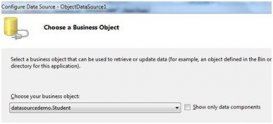各位都把ASP用的函数和详细说明贴出来,供大家学习.
我知道的如下:
1.函数array()
功能:创建一个数组变量
格式:array(list)
参数:list 为数组变量中的每个数值列,中间用逗号间隔
例子:
<% i = array ("1","2","3") %>
结果: i 被赋予为数组
2.函数Cint()
功能:将一表达式/其它类型的变量转换成整数类型(int)
格式:Cint(expression)
参数:expression 是任何有效的表达式/其它类型的变量
例子:
<%
f = "234"
response.write cINT(f) + 2
%>
结果: 236
函数Cint()将字符"234"转换 成整数234.如果表达式为空, 或者无效时,返回值为0;
3.函数:Creatobject()
功能:创建及返回一个ActiveX对象.
格式:Creatobject(obname)
参数bname 是对象的名称
例子:
<%
Set con = Server.CreateObject("ADODB.Connection")
%>
结果:
4.函数Cstr()
功能:将一表达式/其它类型的变量转换成字符类型(string)
格式:Cstr(expression)
参数:expression是任何有效的表达式/其它类型的变量
例子:
<%
s = 3 + 2
response.write "The result is:" & cStr(s)
%>
结果:函数Cstr()将整数 5 转换 成字符"5".
5.函数Date()
功能:返回当前系统(server端)的日期
格式: Date()
参数:无
例子<% date () %>
结果:05/10/00
6.函数Dateadd()
功能:计算某个指定的时间和
格式: dateadd(timeinterval,number,date)
参数:timeinterval是时间单位(月,日..); number是时间间隔值,date是时间始点.
例子:
<%
currentDate = #8/4/99#
newDate = DateAdd("m",3,currentDate)
response.write newDate
%> <%
currentDate = #12:34:45 PM#
newDate = DateAdd("h",3,currentDate)
response.write newDate
%>
结果:
11/4/99
3:34:45 PM
其中
"m" = "month";
"d" = "day";
如果是currentDate 格式,则,
"h" = "hour";
"s" = "second";
7.函数Datediff()
功能:计算某量个指定的时间差
格式: datediff(timeinterval,date1,date2[,firstdayofweek[,firstdayofyear]])
参数: timeinterval 是时间单位; date1,date2是有效的日期表达式,firstdayofweek,firstdayofyear 是任意选项.
例子:
<%
fromDate = #8/4/99#
toDate = #1/1/2000#
response.write "There are " & _
DateDiff("d",fromDate,toDate) & _
" days to millenium from 8/4/99."
%>
结果:There are 150 days to millenium from 8/4/99.
8.函数day()
功能:返回一个整数值,对应于某月的某日
格式: day(date)
参数: date是一个有效的日期表达式;
例子<% =date(#8/4/99#) %>
结果:4
9.函数formatcurrency()
功能:转换成货币格式
格式: formatcurrency(expression [,digit[,leadingdigit[,paren[,groupdigit]]]])
参数: expression 是有效的数字表达式;digit表示小数点后的位数;leadingdigit,paren,groupdigit是任意选项.
例子<%=formatCurrency(34.3456)%>
结果34.35
10.函数formatdatetime()
功能:格式化日期表达式/变量
格式: formatdatetime(date[,nameformat])
参数: date为有效的日期表达式/变量;nameformat是指定的日期格式常量名称.
例子<% =formatdatetime("08/04/99",vblongdate) %>
结果:Wednesday,August 04,1999
说明:
-------------------------------------------------------------------<script language=vbs>
for i=0 to 4
alert(" formatdatetime(now,"&i&") 的时候是:"&formatdatetime(now,i))
next
</script>
-------------
描述
返回表达式,此表达式已被格式化为日期或时间。
语法
formatDateTime(Date[, Namedformat])
formatDateTime 函数的语法有以下参数:
参数 描述
Date 必选项。要被格式化的日期表达式。
Namedformat 可选项。指示所使用的日期/时间格式的数值,如果省略,则使用 vbGeneralDate。
设置
Namedformat 参数可以有以下值:
常数 值 描述
vbGeneralDate 0 显示日期和/或时间。如果有日期部分,则将该部分显示为短日期格式。如果有时间部分,则将该部分显示为长时间格式。如果都存在,则显示所有部分。
vbLongDate 1 使用计算机区域设置中指定的长日期格式显示日期。
vbShortDate 2 使用计算机区域设置中指定的短日期格式显示日期。
vbLongTime 3 使用计算机区域设置中指定的时间格式显示时间。
vbShortTime 4 使用 24 小时格式 (hh:mm) 显示时间。
说明
下面例子利用 formatDateTime 函数把表达式格式化为长日期型并且把它赋给 MyDateTime:
Function GetCurrentDate
"formatDateTime 把日期型格式化为长日期型。
GetCurrentDate = formatDateTime(Date, 1)
End Function
--------------------------------------------------------------------------------
<script language=vbs>
for i=0 to 4
alert(" formatdatetime(now,"&i&") 的时候是:"&formatdatetime(now,i))
next
</script>
[Ctrl+A 全部选择 提示:你可先修改部分代码,再按运行]
11.函数Isnumeric()
功能:返回一个布尔值,判断变量是否为数字变量,或者是可以转换成数字的其它变量.
格式:isnumeric(expression)
参数:expression 是任意的变量.
例子:
<%
i="234"
response.write isnumeric(i)
%>
结果: true.
12.函数Isobject()
功能:返回一个布尔值,判断变量是否为对象的变量,
格式: isobject(expression)
参数: expression 是任意的变量.
例子:
<%
set con =server.creatobject("adodb.connection")
response.write isobject(con)
%>
结果: true
13.函数:Lbound()
功能:返回一个数组的下界.
格式:Lbound(arrayname[,dimension])
参数:arrayname 是数组变量,dimension 是任意项
例子:
<%
i = array("1","2","3")
response.write lbound(i)
%>
结果:0
14.函数Lcase()
功能:将一字符类型变量的字符全部变换小写字符.
格式:Lcase(string)
参数:string是字符串变量
例子:
<%
str="THIS is Lcase!"
response.write Lcase(str)
%>
结果:this is lcase!
15.函数left()
功能:截取一个字符串的前部分;
格式:left(string,length)
参数:string字符串,length截取的长度.
例子: <% =left("this is a test!",6) %>
结果:this i
16.函数len()
功能:返回字符串长度或者变量的字节长度
格式:len(string *varname)
参数:string字符串;varname任意的变量名称
例子:
<%
strtest="this is a test!"
response.write len(strtest)
%>
结果:15
17.函数ltrim()
功能:去掉字符串前的空格.
格式:ltrim(string)
参数:string 字符串.
例子: <% =ltrim (" this is a test!")
结果:this is a test!
18.函数Mid()
功能:从字符串中截取字符串.
格式:mid(string,start [,length])
参数:string字符串,start截取的起点,length要截取的长度.
例子:
<%
strtest="this is a test, Today is Monday!"
response.write mid(strtest,17,5)
%>
结果:Today
19.函数minute()
功能:返回一数值, 表示分钟
格式:minute(time)
参数: time是时间变量
例子lt;% =minute(#12:23:34#) %>
结果:23
20.函数month()
功能:返回一数值, 表示月份
格式:month(time)
参数:time是日期变量
例子<% =month(#08/09/99) %>
结果:9
21.函数monthname()
功能:返回月份的字符串(名称).
格式:Monthname(date [,abb])
参数: date是日期变量,abb=true时 则月份的缩写,
例子:
<% =monthname(#4/5/99#) %>
结果:April
22.函数Now()
功能:返回系统的当前时间和日期.
格式:now()
参数:无
例子:
<% =now() %>
结果: 05/10/00 8:45:32 pm
23.函数:replace()
功能:在字符串中查找,替代指定的字符串.
格式:replace(strtobesearched,strsearchfor,strreplacewith [,start[,count[,compare]]])
参数:strtobesearched是字符串; strsearchfor是被查找的子字符串;strreplacewith 是用来替代的子字符串.start,count,compare 是任意选项.
例子:
<%
strtest="this is an apple."
response.write replace(strtest,"apple","orange")
%>
结果:this is an orange.
24.函数right()
功能:截取一个字符串的后部分
格式:right(string,length)
参数:string字符串,length截取的长度.
例子:
<%
strtest="this is a test!"
response.write right(strtest,3)
%>
结果:st!
25.函数rnd()
功能:返回一个随机数值
格式:rnd[(number)]
参数:number是任意数值.
例子:
<%
randomize()
response.write rnd()
%>
结果:0/1数值之一,无randomize(), 则不能产生随机数.
26.函数round()
功能:完整数值
格式:round(expression[,numright])
参数:expression数字表达式;numright任意选项.
例子:
<%
i=12.33654
response.write round(i)
%>
结果: 12
27.函数rtrim()
功能:去掉字符串后的空格.
格式:rtrim(string)
参数:string 是字符串
例子:
<%
response.write rtrim("this is a test! ")
%>
结果:this is a test!
28.函数second()
功能:返回一个整数值.
格式:second(time)
参数:time是一个有效的时间表达式;
例子lt;% =second(# 12:28:30#) %>
结果:30
29.函数strReverse()
功能:返回与原字符串排列逆向的字符串.
格式:strreverse(string)
参数:string是字符串
例子<% =strreverse("this is a test!")
结果:!tset a si siht
30.函数time()
功能:返回当前系统的时间值.
格式:time()
参数:无
结果:9:58:28 Am
31.函数trim()
功能:删去字符串前,后的空格.
格式:trim(string)
参数:string 字符串.
例子:
<%
strtest=" this is a test! "
response.write trim(strtest)
%>
结果:this is a test!
32.函数UBound()
功能:返回一个数组的上界.
格式:Ubound(expression [,dimension])
参数:expression 是数组表达式/数组变量,dimension 是任意项
例子:
<%
i = array("1","2","3")
response.write ubound(i)
%>
结果: 2
33.函数:UCase()
功能:将一字符类型变量的字符全部变换成大写字符.
格式:Ucase(string)
参数:string是字符串变量
例子:
<%
str="THIS is Lcase!"
response.write Lcase(str)
%>
结果:THIS IS LCASE!
34.函数Vartype()
功能:返回变量的常量代码(整数)
格式:Vartype(varname)
参数:varname是任何类型的变量名称.
例子:
<%
i=5
response.write vartype(i)
%>
结果:2 (2表示整数,须要参考ASP常量代码.)
35.函数Weekday()
功能:返回一个整数,对应一周中的第几天.
格式:Weekday(date [,firstofweek])
参数: date为日期变量,firstofweek为任选项.
例子:
<%
d= # 5/9/00 #
response.write weekday(d) %>
结果:3(3 表示是星期二)
36.函数weekdayname()
功能:返回字符串,对应星期几.
格式:weekdayname(weekday[,abb[,firstdayofweek]])
参数:weekday为日期变量,abb,firstdayofweek为任选项.
例子:
<%
d = #8/4/99#
response.write weekdayname(d)
%>
结果: Wednesday
37.函数year()
功能:返回日期表达式所在的年份.
格式:year(date)
参数: date是有效的日期表达式
例子:
<% =year(#8/9/99#) %>
结果:1999
38.函数Mod()功能:取余数.
例子:3 Mod 2
结果:1
我先介绍一下Split函数的用法:
返回值数组 = Split("字符串","分割符")
39.split函数的应用
作者:李春光 转贴自:本站原创 点击数:113 文章录入:
split 是一个分隔字符串的函数,它的作用是把用特定分隔符隔开的字符串转化为一个数组,这在编程中用的比较多,如上传多张图片,在数库中仅能用一个字段存储的情况下,split就起作用了,下面是一个具体的例子,和数组结合使用.
<%
dim str1
str1="icerain|fengling|windbell|"
aryReturn=split(str1,"|")
response.write "返回的是否为数组"&IsArray(aryReturn)
response.write "<br>"
for i=LBound(aryReturn) TO UBound(aryReturn)
response.write aryReturn(i)
response.write "<br>"
next
response.end
%>
Rnd()
函数产生一个随机数.
表达式 Rnd [ (number) ]
实例: <%
Randomize()
response.write RND()
%>
返回结果: 任何一个在0 到 1 之间的数
ASP中常用的函数和详细说明
2019-10-23 12:13asp教程网 ASP教程
各位都把ASP用的函数和详细说明贴出来,供大家学习. 我知道的如下: 1.函数array() 功能:创建一个数组变量 格式:array(list) 参数:list 为数组变量中的每个数值列,中间用逗号间隔 例子: % i = array (1,2,3) % 结果: i 被赋予为数组 2.函数Cint()
延伸 · 阅读
- 2022-03-11Python 函数装饰器应用教程
- 2022-03-11Python全栈之文件函数和函数参数
- 2022-03-10C++ 函数的介绍
- 2022-03-10Python全栈之路正则函数
- 2022-03-10详解Python的函数与异常
- 2022-03-09C语言system函数使用方法详解
- ASP教程

asp Access数据备份,还原,压缩类代码
asp Access数据备份,还原,压缩类实现代码,大家可以参考下。...
- ASP教程

asp之基于adodb.stream的文件操作类
asp之基于adodb.stream的文件操作类...
- ASP教程

JScript中遍历Request表单参数集合的方法
这篇文章主要介绍了JScript中遍历Request表单参数集合的方法,本文以遍历Request.QueryString集合为例给出了实现代码,需要的朋友可以参考下...
- ASP教程

ASP常用函数:getpy()
ASP常用函数:getpy()...
- ASP教程

asp+javascript实现404页的处理转换
asp+javascript实现404页的处理转换...
- ASP教程

ASP.NET 数据源
数据源 一个 data sourse 控件与数据绑定的控件相互作用,并隐藏了复杂的数据的联编过程。这些是提供数据给 data bound 控件的工具,并且支持如插入,删除...
- ASP教程

asp 标记字符串中指定字符变色不区分大小写
今天遇到这种问题,单纯的使用replace函数不行,他会改变原有的字符串的大小写,在网上找到相关的代码,自己备份下...
- ASP教程

asp 采集实战代码
最近实在是太流行采集了,本人是不喜欢采集的,但对采集的原理我却很有兴趣进行研究,拿到了网上采集常用函数,对其进行了一番研究,并实战,结果...












